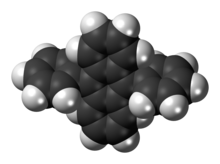9,10-Diphenylanthracene
Appearance
(Redirected from 9,10-diphenylanthracene)

| |

| |
| Names | |
|---|---|
| IUPAC name
9,10-Diphenylanthracene
| |
| Identifiers | |
3D model (JSmol)
|
|
| Abbreviations | DPA |
| 1914010 | |
| ChEBI | |
| ChemSpider | |
| ECHA InfoCard | 100.014.641 |
| EC Number |
|
PubChem CID
|
|
| UNII | |
CompTox Dashboard (EPA)
|
|
| |
| |
| Properties | |
| C26H18 | |
| Molar mass | 330.42 |
| Appearance | Yellow powder |
| Density | 1.22 g/cm3[1] |
| Melting point | 248 to 250 °C (478 to 482 °F; 521 to 523 K) |
| Hazards | |
| GHS labelling: | |

| |
| Warning | |
| H315, H319, H335 | |
| P261, P264, P271, P280, P302+P352, P304+P340, P305+P351+P338, P312, P321, P332+P313, P337+P313, P362, P403+P233, P405, P501 | |
Except where otherwise noted, data are given for materials in their standard state (at 25 °C [77 °F], 100 kPa).
| |
9,10-Diphenylanthracene is a polycyclic aromatic hydrocarbon. It has the appearance of a slightly yellow powder. 9,10-Diphenylanthracene is used as a sensitiser in chemiluminescence. In lightsticks it is used to produce blue light. It is a molecular organic semiconductor, used in blue OLEDs and OLED-based displays.
See also
[edit]- 2-Chloro-9,10-diphenylanthracene, a chlorinated derivative
References
[edit]- ^ Adams JM, Ramdas S (1979). "The Crystal Structure of Solution-Grown 9,10-Diphenylanthracene. A Combined Computational and X-Ray Study". Acta Crystallographica Section B. 35 (3): 679–683. Bibcode:1979AcCrB..35..679A. doi:10.1107/s0567740879004428.
External links
[edit]- Polycyclic aromatic hydrocarbons, Australian National Pollutant Inventory
